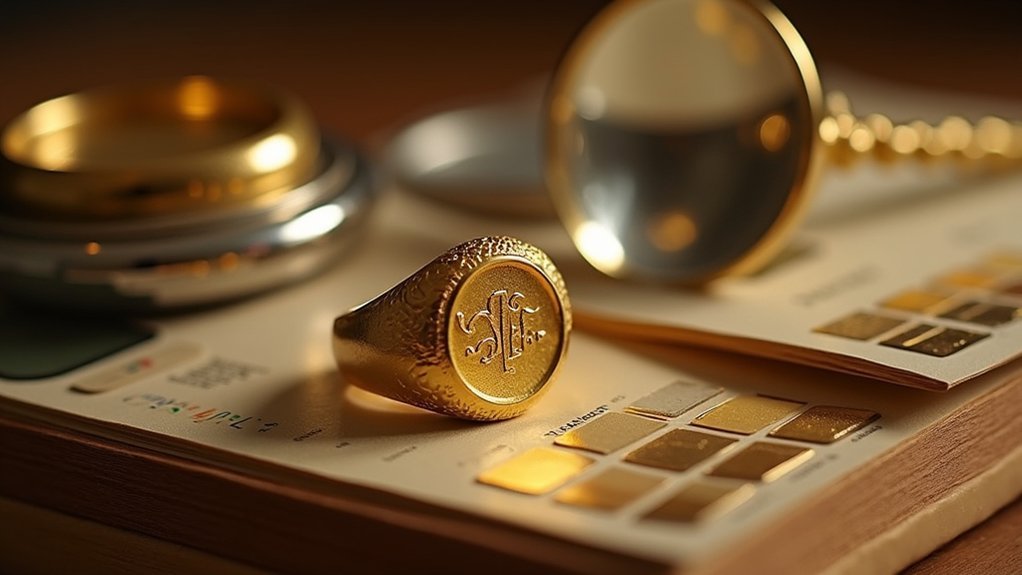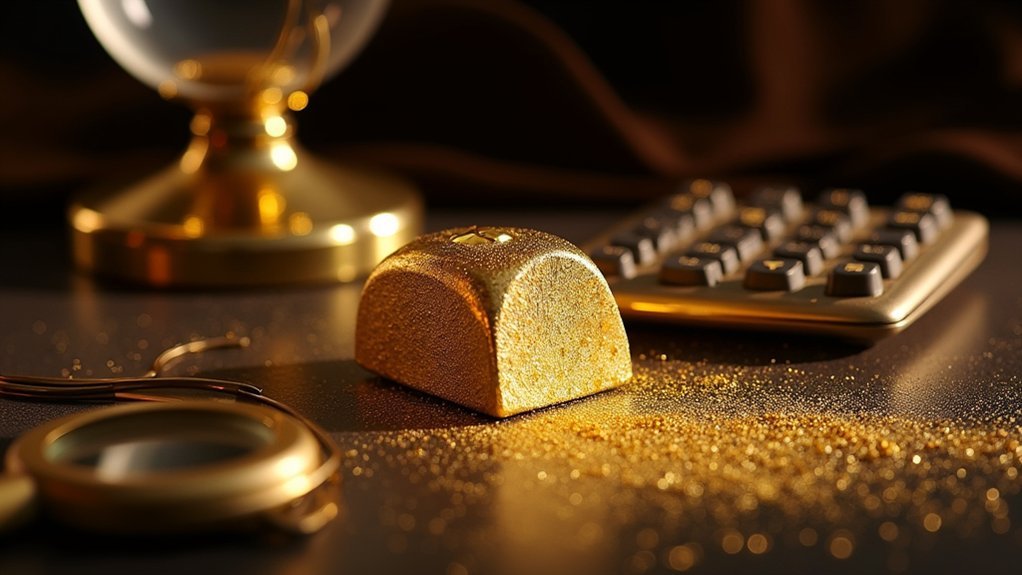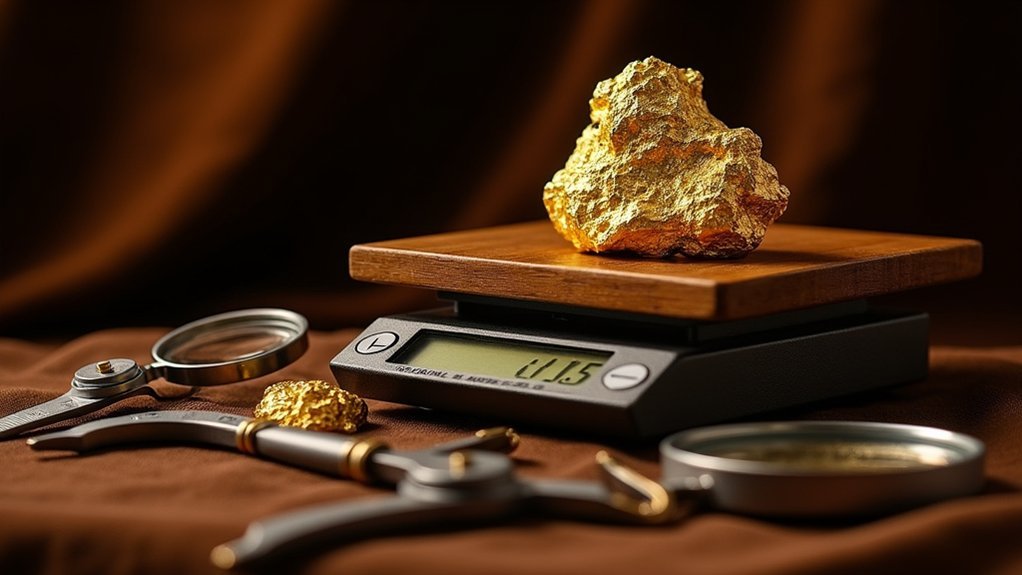To calculate your gold’s true worth, you’ll need to identify its karat purity using hallmarks found inside rings or on clasps, then weigh it precisely using a digital gram scale. Convert the karat value to a decimal percentage by dividing by 24 (18k = 0.75), then multiply the weight by purity and current market price per gram. This formula gives you the melt value, though factors like craftsmanship and brand reputation can increase resale value beyond this baseline calculation.
Understanding Gold Purity and Karat Markings

Before you can accurately calculate gold’s worth, you’ll need to understand the karat system that measures gold purity. The karat scale runs from 10K to 24K, with 24K representing 100% pure gold. Common jewelry purities include 18K (75% gold), 14K (58.3% gold), and 10K (41.7% gold). Each karat value directly correlates to the percentage of actual gold in your piece.
Look for karat markings stamped on your jewelry – typically found inside rings or on clasps. These hallmarks display “10k,” “14k,” “18k,” or “24k” to indicate the purity of gold.
If you can’t find visible markings, gold testing kits can confirm the actual content. Understanding these karat markings is essential since higher karat numbers mean greater gold content, which directly impacts the value of your gold items.
Weighing Your Gold Jewelry Accurately
You’ll need a digital scale that measures in grams to get accurate weight readings for your gold jewelry.
Make sure you calibrate the scale properly so it measures to the hundredth of a gram, since precise measurements directly impact your gold’s value calculation.
Always record the weight in grams rather than ounces, as this gives you more precision when working with smaller jewelry pieces.
Choose Digital Gram Scale
One essential tool stands between you and accurate gold valuation: a digital gram scale. You’ll need this precision instrument to accurately calculate your jewelry’s worth, as weight in grams directly impacts the final value regardless of the purity of your gold.
Choose a digital scale that measures to the hundredth of a gram for maximum accuracy. Common kitchen scales won’t provide the precision you need for serious gold evaluation. Fortunately, quality digital gram scales are affordable, typically priced under $10.00, making them accessible for anyone.
Regularly check your scale’s calibration to guarantee consistent, reliable measurements. This simple step ensures you’re getting true weight readings, which are vital for determining your gold’s actual market value.
Calibrate for Precise Measurements
A properly calibrated scale means the difference between an accurate valuation and a costly mistake. Before weighing your gold jewelry, you must calibrate your digital gram scale to guarantee precision. Use the calibration weights that came with your scale, or purchase certified weights separately.
Place the known weight on the scale and adjust according to manufacturer instructions until it displays the exact weight.
Even minor calibration errors can greatly impact your gold’s calculated value, especially when gold price fluctuates. A scale that’s off by just 0.1 grams on a 10-gram piece could cost you considerably.
After calibration, test with multiple known weights to verify accuracy. Recalibrate regularly, particularly if you’ve moved the scale or notice inconsistent readings, to maintain reliable weight measurements.
Record Weight in Grams
Once your scale displays accurate readings, place your gold jewelry directly on the weighing platform and record the measurement in grams to at least two decimal places. This precision becomes essential when you calculate your jewelry’s value against the current market price.
| Jewelry Type | Weight (grams) | Purity |
|---|---|---|
| Wedding Ring | 4.25 | 14K |
| Chain Necklace | 12.80 | 18K |
| Earring Set | 2.15 | 10K |
| Bracelet | 8.90 | 14K |
| Pendant | 3.45 | 18K |
Document each piece separately if you’re evaluating multiple items. You’ll need these exact measurements to determine fair market value or for a professional appraisal. Don’t round numbers—every hundredth of a gram affects your jewelry’s worth. Keep detailed records including the date of weighing for future reference.
Finding and Reading Hallmarks on Gold Items
Before determining your gold item’s worth, you’ll need to locate and interpret its hallmark—a small stamp that reveals the gold’s purity level. Hallmarks on gold items typically appear on the inner side of jewelry or discreet areas, so inspect closely with good lighting or a magnifying glass.
Common stamps include 10k (41.66% gold), 14k (58.33% gold), 18k (75% gold), and 24k (100% gold). Higher karat numbers indicate greater purity and value.
You might also find manufacturer logos, country marks, or certification symbols that verify the authenticity of your gold.
If you can’t locate a hallmark, don’t assume the item’s worthless. Use a gold testing kit or consult a professional appraiser to confirm purity and ascertain accurate valuation for your piece.
Converting Karat Values to Decimal Percentages

After identifying your gold item’s karat marking, you’ll need to convert that number into a decimal percentage to calculate its actual gold content.
Gold purity is measured in karats, where 24 karats represents 100% pure gold. To convert any karat value to a decimal percentage, simply divide the karat number by 24.
For example, 18k gold equals 18÷24 = 0.75 or 75% gold content. Similarly, 14k gold contains 14÷24 = 0.583 or 58.3% gold, while 10k gold has 10÷24 = 0.417 or 41.7% gold content.
This conversion is essential for determining the value of your gold because you’re only paying for the actual gold content, not the entire weight of the item including other metals.
Researching Current Gold Market Prices
You’ll need to track live gold prices since they change constantly throughout trading hours based on market conditions and global events.
Start by checking reliable financial websites or dedicated gold trading platforms that display real-time pricing per troy ounce.
Don’t just look at current prices—analyze recent market trends to understand whether gold’s moving up or down over days, weeks, and months.
Live Price Tracking
Since gold prices fluctuate every minute based on market demand and economic conditions, you’ll need to track live pricing data to get an accurate valuation of your gold items. Financial websites and market data sources provide real-time current market prices quoted per gram or ounce, making it easier to stay informed about the market price of gold.
Set up alerts from trusted financial news sources to monitor notable price changes throughout the day. This approach helps you make strategic decisions when selling gold, as timing can greatly impact your profits.
Geopolitical events, currency fluctuations, and economic stability all influence gold values, so consistent monitoring guarantees you won’t miss prime selling opportunities or make uninformed investment choices.
Market Trend Analysis
While live price tracking gives you current values, market trend analysis helps you understand the broader patterns that drive gold’s price movements over weeks, months, and years.
You’ll need to examine historical data to identify whether current gold prices are trending upward, downward, or remaining stable. Market trends reveal vital information about economic conditions, geopolitical events, and demand fluctuations that affect gold’s value.
Start by reviewing price charts spanning different timeframes—daily, weekly, monthly, and yearly patterns. Look for support and resistance levels that indicate where prices might stabilize or reverse.
Understanding these market trends becomes essential when calculating the value of your gold holdings, as timing your transactions based on trend analysis can greatly impact your returns versus selling during unfavorable market conditions.
Using the Gold Value Calculation Formula

Three essential components form the foundation of gold valuation: weight, purity, and current market price.
Gold’s true worth depends on three fundamental factors: the item’s weight, its purity level, and today’s fluctuating market rates.
You’ll use this straightforward formula: Value = Weight (in grams) × Purity (as a decimal) × Market Price per gram.
Start by weighing your gold item using a digital scale, ensuring measurements are in grams for accuracy.
Next, convert your gold’s karat rating to decimal format—14k becomes 0.585, while 18k equals 0.75.
Then check today’s market price per gram, which currently sits at approximately $104.25.
Now you’re ready to calculate the price. Simply multiply these three numbers together.
For example, a 10-gram 14k gold ring would be: 10 × 0.585 × $104.25 = $609.86.
This formula gives you your gold’s true market value.
Factors That Influence Gold Pricing Beyond Weight
Although the basic formula provides a foundation for calculating gold value, several additional factors can greatly alter what you’ll actually receive when selling your pieces.
Market demand fluctuates with economic conditions and geopolitical events, causing prices to swing beyond spot gold rates. Your jewelry design matters greatly – unique craftsmanship and recognized brand names command premium prices that exceed raw material worth.
Historical significance or rarity creates numismatic value that collectors prize above gold weight alone. Gemstones and intricate details enhance aesthetic appeal, boosting overall value considerably.
Don’t underestimate emotional attachment either – personal stories and sentimental connections can influence what buyers will pay.
These factors combined mean your gold’s value often surpasses simple weight calculations, making professional appraisal essential for accurate pricing.
Professional Appraisal vs. Self-Assessment Methods

You’ll face a key decision when determining your gold’s value: rely on professional testing accuracy or use DIY assessment tools.
Professional appraisers use specialized equipment like electronic testers and acid tests that deliver precise purity readings, while home testing kits and basic scales can give you quick estimates.
The choice depends on whether you need definitive results for insurance or sales purposes, or just want a ballpark figure for your own knowledge.
Professional Testing Accuracy
When determining your gold’s true value, the accuracy gap between professional appraisals and self-assessment methods can mean the difference between hundreds or even thousands of dollars.
Professional appraisals utilize certified gemologists who possess specialized equipment and expertise to deliver accurate assessments of your gold’s true worth. They’ll precisely measure gold purity using advanced testing methods that detect even minute variations in karat quality.
Unlike basic home testing kits, professional evaluations consider craftsmanship, design elements, and brand significance that dramatically impact value beyond simple melt calculations. This thorough approach often reveals hidden worth you’d miss through self-assessment.
Additionally, certified documentation from professional appraisers enhances resale opportunities by providing buyers with credible verification of your gold’s quality and authenticity, ultimately maximizing your return.
DIY Tool Options
Several accessible DIY tools can help you assess your gold’s value from home, though they’ll provide estimates rather than definitive appraisals. Digital gram scales offer precise weight measurements, while gold testing kits verify purity through acid tests.
| Tool | Purpose | Cost Range |
|---|---|---|
| Digital Gram Scale | Accurate weight measurement | $15-$50 |
| Gold Testing Kit | Purity verification | $20-$60 |
For self-assessment calculations, use this formula: Value = Weight (grams) × Purity (decimal) × Current Market Price Per Gram. While these tools provide quick estimates, they can’t account for craftsmanship or historical significance that professional appraisals consider. You’ll need official evaluations for unique pieces, but DIY methods work well for standard gold jewelry and scrap calculations.
Comparing Melt Value to Resale Value
Understanding gold’s worth requires distinguishing between two key valuations: melt value and resale value. Your melt value represents the raw worth of your gold items based strictly on weight, purity, and current market price. You’ll calculate this using the formula: Weight × Purity × Current Market Price per gram.
However, your resale value often exceeds melt value considerably. Factors like craftsmanship, brand reputation, historical significance, and emotional attachment boost worth beyond mere metal content. Custom or unique pieces typically command higher resale prices because buyers value design and story.
When you approach jewelers or pawn shops, they’ll usually offer close to melt value, ignoring artistry.
Remember that melt value fluctuates with market conditions, so you’ll need current pricing for accurate calculations.
Tools and Equipment for Gold Evaluation

Accurate gold evaluation depends on having the right tools at your disposal.
You’ll need a digital gram scale for precise weight measurements, as accuracy is vital for valuation calculations. These scales typically cost under $10.00 and provide the precision necessary for proper assessments.
When hallmarks aren’t visible, basic gold testing kits help confirm your item’s purity. You can find these online for under $20.00, making them an affordable investment.
Always weigh your gold in grams rather than other units for maximum precision in your calculations.
A gold calculator streamlines the evaluation process by allowing you to input weight, purity, and current market price for quick value estimates.
Investing around $30.00 in these essential tools provides a solid foundation for accurate gold evaluation.
Frequently Asked Questions
How Do I Calculate How Much My Gold Is Worth?
You’ll weigh your gold in grams, check its karat marking for purity, then multiply weight times purity percentage times current gold price per gram to determine its worth.
How Do You Calculate the Real Value of Gold?
You’ll calculate gold’s real value by weighing it precisely, determining its purity percentage, checking current market prices, then multiplying weight times purity times price per gram for accurate valuation.
How Is Gold’s Value Determined?
Gold’s value depends on three main factors you’ll need to evaluate: its weight, purity level measured in karats, and current market prices that change daily based on economic conditions and global demand.
How Do I Know if My Gold Is Worth Anything?
Check your gold’s karat marking first – higher numbers mean more value. Weigh it accurately, then multiply the weight by purity percentage and current market price to calculate what it’s actually worth.
In Summary
You’ve learned the essential steps to determine your gold’s true worth. Don’t forget to verify karat markings, weigh accurately, and check current market prices. Remember that factors like craftsmanship and brand affect resale value beyond melt worth. Whether you’re selling to a dealer or keeping for investment, you’ll make informed decisions with proper evaluation. Consider professional appraisal for valuable pieces, but you’re now equipped to assess most gold items yourself confidently.





Leave a Reply